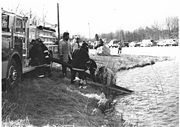
Draft (water)
Encyclopedia

Suction
Suction is the flow of a fluid into a partial vacuum, or region of low pressure. The pressure gradient between this region and the ambient pressure will propel matter toward the low pressure area. Suction is popularly thought of as an attractive effect, which is incorrect since vacuums do not...
pump
Pump
A pump is a device used to move fluids, such as liquids, gases or slurries.A pump displaces a volume by physical or mechanical action. Pumps fall into three major groups: direct lift, displacement, and gravity pumps...
. A rural fire department
Volunteer fire department
See also the Firefighter article and its respective sections regarding VFDs in other countries.A volunteer fire department is a fire department composed of volunteers who perform fire suppression and other related emergency services for a local jurisdiction.The first organized force of...
or farmer might draft water from a pond as the first step in moving the water elsewhere. A suction pump creates a partial vacuum (a "draft") and the atmospheric pressure
Atmospheric pressure
Atmospheric pressure is the force per unit area exerted into a surface by the weight of air above that surface in the atmosphere of Earth . In most circumstances atmospheric pressure is closely approximated by the hydrostatic pressure caused by the weight of air above the measurement point...
on the water's surface forces the water into the pump, usually via a rigid pipe (sometimes called a "dry hydrant") or a semi-rigid "hard suction hose
Hard suction hose
Hard suction hose is a specific type of fire hose used in drafting operations, when a fire engine uses a vacuum to draw water from a portable water tank, pool, or other static water source. It is built to withstand vacuum, rather than pressure, abrasion, and heat...
".
Standard atmospheric pressure is 101 kPa (14.7 lbf/in²) and that can only raise water to a theoretical maximum of 10.3 metres (33.9 ft). Depending on application, fire department pumps lift water 6 to 10 metres (20 to 30 ft).

It is also possible to use a gravity siphon
Siphon
The word siphon is sometimes used to refer to a wide variety of devices that involve the flow of liquids through tubes. But in the English language today, the word siphon usually refers to a tube in an inverted U shape which causes a liquid to flow uphill, above the surface of the reservoir,...
to draft water for a small lift, and this technique is often used in forest fire suppression, where portable reservoirs of 1,000 to 3,000 US gallons (5 to 10 m³) are filled with water and small hoses are used downhill of the tanks. The nozzle pressure is proportional to its distance below the reservoir surface. Forty-three percent of the distance, in feet, is approximately the number of pounds per square inch pressure (e.g., 100 feet lower: 43 psi). The tank may itself be gravity-fed through hoses from a nearby water source, or by pumps or helicopters delivering water from further away.
See also
- Glossary of firefighting termsGlossary of firefighting termsFirefighting jargon includes a diverse lexicon of both common and idiosyncratic terms. One problem that exists in trying to create a list such as this is that much of the terminology used by a particular department is specifically defined in their particular standing operating procedures, such that...
- Portable water tankPortable water tankA portable water tank is a collapsible temporary tank designed for the reserve storage of water in firefighting, emergency relief, and military applications. These tanks can be either supported or unsupported. The supported tanks have a steel or aluminum frame and range in size from 600 to 5000 US...

